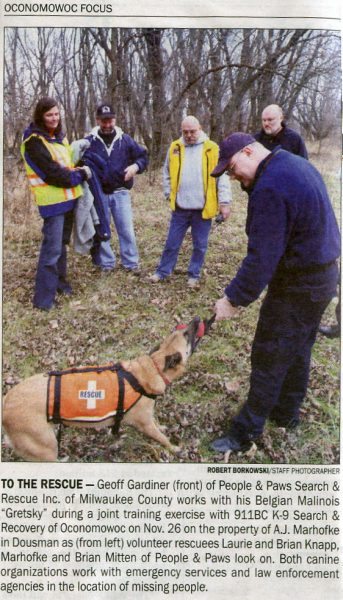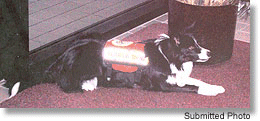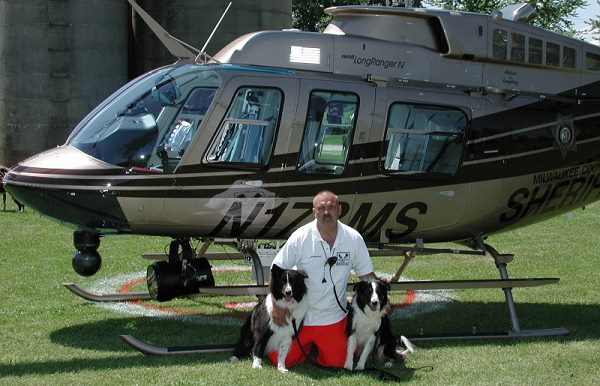Finding What is Lost
By STEVE LOUDEN – Freeman Staff February 27, 2002
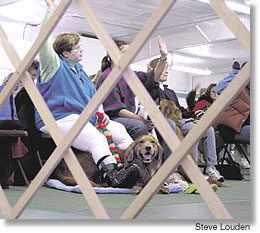
Carol Munden raises her hand to answer
a question during a search and recovery training course headed by 911BC founder A.J. Marhofke. 911BC Search and Recovery, based in the town of Summit, uses border collies Molly Mae and Zip
in area and national search and recovery missions. Munden is training Doogan, a 3-year-old golden retriever.
TOWN OF IXONIA – The act of finding a lost person brings closure to the family of the one who is lost.
Many of those who take part in search and recovery missions have that goal in mind. They express a desire to help people they may have never met.
That is one reason Julie Kolp of Hustisford enrolled herself and her Australian shepherd, Mic, in a search-and-recovery training course.
“Mainly, we hope to help people and their families,” Kolp said. “I can’t imagine losing a loved one and not having closure.”
Carolyn Ciampi of Waukesha said the tragic events of Sept. 11 piqued her growing interest in search and recovery.
“Someday I would like to part of a team of dogs and people that can help out at various kinds of disasters,” Ciampi said. “Being able to do this would be the ultimate I can give to help another human in need.”
Ciampi decided to enroll herself and her elderly Belgian sheepdog mix, Shadow, 7, in a search-and-recovery training course headed by 911BC Search and Recovery founder A.J. Marhofke. Marhofke’s organization, based in the town of Summit, uses border collies Molly Mae and Zip in local and national search-and-recovery missions.
Tools for training
There are certain traits a dog must show to become a good search dog, he said
“He has to be nosy – he has to like to get into stuff,” Marhofke said. “He has to be sure of himself. He has to be extremely friendly.”
Aggressive dogs are not allowed on a search-and-recovery team, Marhofke said. The dog must be people-oriented and willing to please.
“They’re trained to find people, not hurt them,” Marhofke said.
Marhofke is holding the course at the Western Waukesha County Dog Training Club, in the town of Ixonia. About 40 people are taking the course.
Training starts with the basics – sit, stay and socialization. Dogs must learn the basic commands before they start onto the next steps, Marhofke said. Then they can begin field training and the basics of search and recovery. They must learn to follow human scent and find human remains.
Trainers are taught survival skills, first aid and map, compass and Global Positioning System reading. They are also taught what to do in the field and at a crime scene, and how to log information into a log book.
So why train a dog for search and recovery?
“We feel strongly that dogs should be a part of society – that they should be useful and earn their kibble,” Judy Shonborn said. “Just like people who don’t have meaningful work, we believe that dogs suffer if they don’t have enough exercise and mental stimulation.”
Mike and Judy Shonborn of Greenfield are taking the course with their giant Schnauzers Charlie, 5, and Rachel, 6.
Training for a cause
“Search and recovery is cool because it combines diverse dog disciplines, such as obedience, hunting, tracking, agility, etc., and it’s all for a great cause,” Claudia Barreto of Glendale, said.
Barreto and her sister-in-law, Ellen Hohenfeldt of Brookfield, are taking the course with their dogs, a Labrador named Miracle and an Australian shepherd called Libby, respectively.
“I’m taking it mostly because I like training dogs and working with my dogs,” Hohenfeldt said. “It gives us something to do together.”
Though there are people who get into search and recovery because they want to help people, Hohenfeldt said that is not her current goal.
“The dog work and training come before that,” she said. “Besides, I tend to be more interested in forensic work – that is dealing with corpses rather than live people.”
Dona Barsul of Wauwatosa and her two dogs, Merlin and Nisso, are knee-deep in the grim side of search and recovery. Barsul said she first got involved in search and recovery about 10 years ago.
“It combines my love of the outdoors with my passion for training dogs,” Barsul said. “I thought it would be a great way to help people.”
She said her particular interest is in the forensics and cadaver aspect.
“It is like solving a mystery, knowing we could help solve a crime or bring closure to someone’s life,” Barsul said.
With an interest in archeology and a penchant for mystery novels, Aimee Ukasick of Milwaukee said she thought it would be interesting to get Maddy, her dachshund-Shetland sheepdog-Tibetan Spaniel mix, involved in search and recovery.
“Finding living people isn’t really my bag,” Ukasick said. “Finding cadavers holds much more interest for me.”
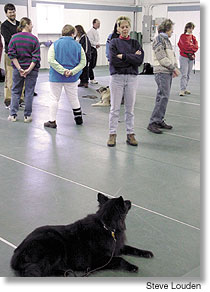
Carolyn Ciampi of Waukesha works on a “stay” command with her 7-year-old Belgian sheep dog mix Shadow. Dogs and their trainers must know numerous commands they will use in the field. These tips are taught in a search and recovery training course headed by 911BC founder A.J. Marhofke.
Forensic science
“I was interested in the forensic and cadaver aspect of the search-and-recovery work he (Marhofke) did,” Deanne Phillips of Oak Creek said. “The first time Bella did a simulated search and there was a person at the end waiting for her, she was very excited. It was like hide-and-go-seek with treats and pets at the end.”
Phillips’ beagle also showed a knack for finding forensic material.
“The first time that she found cadaver material, however, it was like a whole new world,” Phillips said. “I was amazed at how she could differentiate human from animal bones, even picking out soil from an ancient Indian burial ground.”
Charlotte Allmann of Wauwatosa has trained dogs in obedience for more than 30 years. An incident when her neighbor was missing while fishing Oconomowoc Lake is one reason she and Clue, her petit basset griffon Vendeen, are working with Marhofke.
“His body wasn’t found for quite some time, leaving his wife with a lot of questions and personal turmoil,” Allmann said. “That didn’t have to happen. A canine search team could have found the body quickly.”
When Allmann observed how much her young dog liked to use his nose, she decided to look into search and recovery.
“There is a kind of magic in following along behind a dog who is sharing knowledge that only he knows. It gives me goose bumps,” Allmann said.

